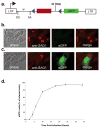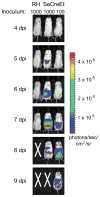Toxoplasma secreting Cre recombinase for analysis of host-parasite interactions
- PMID: 20208532
- PMCID: PMC2850821
- DOI: 10.1038/nmeth.1438
Toxoplasma secreting Cre recombinase for analysis of host-parasite interactions
Abstract
We describe a Toxoplasma gondii strain that will permit the use of site-specific recombination to study the host-parasite interactions of this organism. This Toxoplasma strain efficiently injects a Cre fusion protein into host cells. In a Cre-reporter cell line, a single parasite invasion induced Cre-mediated recombination in 95% of infected host cells. By infecting Cre-reporter mice with these parasites, we also monitored host-cell infection in vivo.
Figures



References
Publication types
MeSH terms
Substances
Grants and funding
- R37 AG009521/AG/NIA NIH HHS/United States
- AG024987/AG/NIA NIH HHS/United States
- R01 EB005011/EB/NIBIB NIH HHS/United States
- AG009521/AG/NIA NIH HHS/United States
- R01 AI021423/AI/NIAID NIH HHS/United States
- R01 AG020961/AG/NIA NIH HHS/United States
- AI41014/AI/NIAID NIH HHS/United States
- EB005011/EB/NIBIB NIH HHS/United States
- K08 NS065116/NS/NINDS NIH HHS/United States
- R01 AI041014/AI/NIAID NIH HHS/United States
- AI21423/AI/NIAID NIH HHS/United States
- AG020961/AG/NIA NIH HHS/United States
- R01 AG024987/AG/NIA NIH HHS/United States
- NS065116/NS/NINDS NIH HHS/United States
- R37 AI021423/AI/NIAID NIH HHS/United States
- R01 AG009521/AG/NIA NIH HHS/United States
LinkOut - more resources
Full Text Sources
Other Literature Sources
Medical

